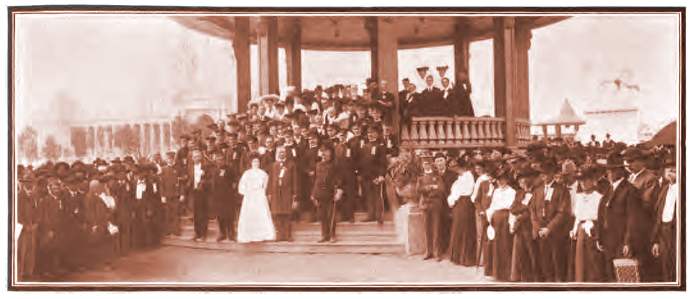Kansas' structure was one of the prettiest pavilions on the grounds. Two stories high, it contained a large central hall on the first floor. There were three grand entrances. The building had a fine location at the junction of three avenues; it covered of 84 by 128 feet and cost 29,745 dollars.
Inside, the structure housed a day nursery and an emergency hospital at the In the south part of the building, complete with a physician.
Of all the State buildings facing on Commonwealth Avenue, none was more home-like or more popular than that of Kansas.
Other rooms included: a large central reception hall, post-office and check room and the spacious offices of the Commission.
The second floor featured a very large gallery of paintings by Kansas artists which included media work of oils, watercolors, pen and ink, drawings and charcoal. A.E. Albright's work was displayed in the state building as well as
chosen to be represented in the Palace of Fine Arts.
All in all, there was works of art in the state building, which included:
Sculpture, paintings in oil, paintings in water colors, pastels and other
drawings, miniatures, etchings, paintings on china, art needlework,
embroideries, etc., tapestries, etc.Kansas made exhibits in the Agriculture, Horticulture ( fruits, especially apples, peaches, plums, grapes, cherries), Education (work from 104 cities and about 400 country districts.), Mines (lead, zinc, coal, salt, gypsum, stone, shale for manufacture of brick, cement, etc.,), and Social Economy buildings.
The state had a huge exhibit of live stock of horses, cattle, swine, sheep, and poultry.
In the Palace of Agriculture, one exhibit included: at the north entrance stood a pyramid of native grasses, upon which was a vase made of oat heads, 7 feet high. Directly opposite stood a pyramid of tame grasses, upon which rested a vase made of the heads of grains and grasses, 7 feet high.
Mrs. Carrie Nation was so upset at the John Noble oil of Cleopatra, that she took a hatchet and punctured its canvas.
The Kansas Pavilion was designed by W. W. Rose, an architect located in Kansas City, who designed the Newton Carnegie Library.





